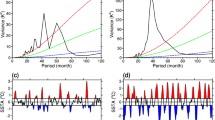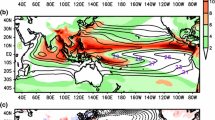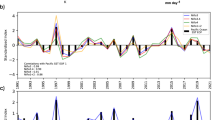Abstract
The seasonal footprinting mechanism (SFM) is thought to be a pre-cursor to the El Nino Southern Oscillation (ENSO). Fluctuations in the North Pacific Oscillation (NPO) impact the ocean via surface heat fluxes during winter, leaving a sea-surface temperature (SST) “footprint” in the subtropics. This footprint persists through the spring, impacting the tropical Pacific atmosphere–ocean circulation throughout the following year. The simulation of the SFM in the National Centers for Environmental Prediction (NCEP)/Climate Forecast System, version 2 (CFSv2) is likely to have an impact on operational predictions of ENSO and potentially seasonal predictions in the United States associated with ENSO teleconnection patterns. The ability of the CFSv2 to simulate the SFM and the relationship between the SFM and ENSO prediction skill in the NCEP/CFSv2 are investigated. Results indicate that the CFSv2 is able to simulate the basic characteristics of the SFM and its relationship with ENSO, including extratropical sea level pressure anomalies associated with the NPO in the winter, corresponding wind and SST anomalies that impact the tropics, and the development of ENSO-related SST anomalies the following winter. Although the model is able to predict the correct sign of ENSO associated with the SFM in a composite sense, probabilistic predictions of ENSO following a positive or negative NPO event are generally less reliable than when the NPO is not active.







Similar content being viewed by others
References
Alexander MA, Matrosova L, Penland C, Scott JD, Chang P (2008) Forecasting Pacific SSTs: linear inverse model predictions of the PDO. J Clim 21:385–402. doi:10.1175/2007JCLI1849.1
Alexander MA, Vimont D, Chang P, Scott JD (2010) The impact of extratropical atmospheric variability on ENSO: testing the seasonal footprinting mechanism using coupled model experiments. J Clim 23:2885–2901. doi:10.1175/2010JCLI3205.1
Anderson BT (2003) Tropical Pacific sea-surface temperatures and preceeding sea level pressure anomalies in the subtropical North Pacific. J Geophys Res 108:148–227. doi:10.1029/2003JD003805
Anderson BT (2007) On the joint role of subtropical atmospheric variability and equatorial subsurface heat content anomalies in initiating the onset of ENSO events. J Clim 20:1593–1599. doi:10.1175/JCLI4075.1
Anderson BT, Perez RC, Karspeck A (2013) Triggering of El Nino onset through trade wind-induced charging of the equatorial pacific. Geophy Res Lett 40:1212–1216. doi:10.1002/grl.50200
Carton JA, Chepurin G, Cao X, Giese BS (2000a) A simple ocean data assimilation analysis of the global upper ocean 1950–1995, part 1: methodology. J Phys Oceanogr 30:294–309
Carton JA, Chepurin G, Cao X (2000b) A simple ocean data assimilation analysis of the global upper ocean 1950–1995 part 2: results. J Phys Oceanogr 30:311–326
Chang P, Ji L, Li H, Flugel M (1996) Chaotic dynamics versus stochastic processes in El Nino Southern Oscillation in coupled ocean-atmosphere models. Physica D 98:301–320. doi:10.1016/0167-2789(96)00116-9
Clarke AJ, Gorder SV (2003) Improving El Nino prediction using a space-time integration of Indo-Pacific winds and equatorial Pacific upper ocean heat content. Geophys Res Lett 30:1399. doi:10.1029/2002GL016673
Clarke AJ, Gorder SV, Colantuono G (2007) Wind stress Curl and ENSO discharge/recharge in the equatorial Pacific. J Clim 37:1077–1091
Deser C, Phillips AS, Tomas RA, Okumura YM, Alexander MA, Capotondi A, Scott JD, Kwon Y, Ohba M (2012) ENSO and the Pacific decadal variability in the community climate system model version. J Clim 4(25):2622–2651. doi:10.1175/JCLI-D-11-00301.1
Di Lorenzo E, Cobb KM, Furtado JC, Schneider N, Anderson BT, Bracco A, Alexander MA, Vimont DJ (2010) Central Pacific El Nino and decadal climate change in the North Pacific Ocean. Nat Geosci 3:762–765. doi:10.1038/NGEO984
Feldstein SB (2000) The timescale, power spectra, and climate noise properties of teleconnection patterns. J Clim 13:4430–4440
Furtado JC, Di Lorenzo E, Anderson BT, Schneider N (2012) Linkages between the North Pacific Oscillation and central tropical Pacific SSTs at low frequencies. Clim Dyn 39:2833–2846. doi:10.1007/s00382-011-1245-4
Gershunov A, Schneider N, Barnett T (2001) Low-frequency modulation of the ENSO-Indian monsoon rainfall relationship: signal or noise? J Clim 14:2486–2492
Jin FF (1997a) An equatorial ocean recharge paradigm for ENSO. Part I: conceptual model. J Atmos Sci 54:811–829
Jin FF (1997b) An equatorial ocean recharge paradigm for ENSO. Part II: a stripped-down coupled model. J Atmos Sci 54:830–847
Kalnay E et al (1996) The NCEP/NCAR 40-year reanalysis project. Bull Am Meteor Soc 77:437–470
Kim ST, Yu J-Y, Kumar A, Wang H (2011) Examination of the two types of ENSO in the NCEP CFS model and its extratropical associations. Mon Wea Rev 140:1908–1923
Linkin ME, Nigam S (2008) The North Pacific Oscillation–West Pacific teleconnection pattern: mature-phase structure and winter impacts. J Clim 21:1979–1996
Meinen CS, McPhaden MJ (2000) Observations of warm water volume changes in the equatorial Pacific and their relationship to El Nino and La Nina. J Clim 13:3551–3559
Mogensen K, Balmaseda MA, Weaver AT, Martin M, Vidard A (2009) NEMOVAR: a variational data assimilation system for the NEMO ocean model. ECMWF Newsl 120:17–22
Moore AM, Kleeman R (1999) Stochatic forcing of ENSO by the intraseasonal oscillation. J Clim 12:1199–1220
Murphy AH (1973) A new vector partition of the probability score. J Appl Climatol 12:595–600
Penland C, Magorian T (1993) Prediction of Nino3 sea surface temperatures using linear inverse modeling. J Clim 6:1067–1076
Penland C, Sardeshmukh PD (1995) The optimal growth of tropical sea surface temperature anomalies. J Clim 8:1999–2024
Rayner NA, Brohan P, Parker DE, Folland CK, Kennedy JJ, Vanicek M, Ansell T, Tett SFB (2006) Improved analyses of changes and uncertainties in sea surface temperature measured in situ since the mid-nineteenth century: the HadSST2 data set. J Clim 19:446–469
Reynolds RW, Rayner NA, Smith TM, Stokes DC, Wang W (2002) An improved in situ and satellite SST analysis for climate. J Clim 15:1609–1625
Rogers JC (1981) The north Pacific oscillation. J Climatol 1:39–57. doi:10.1002/joc.3370010106
Saha S et al (2010) The NCEP climate forecast system reanalysis. Bull Am Meteor Soc 9:1015–1057. doi:10.1175/2010BAMS3001.1
Saha S et al (2012) The NCEP climate forecast system version 2. J Clim (submitted)
Thompson CJ, Battisti DS (2000) A linear stochastic dynamical model of ENSO. Part 1: model development. J Clim 13:2818–2832
Thompson CJ, Battisti DS (2001) A linear stochastic dynamical model of ENSO. Part II: analysis. J Clim 14:445–466
Vimont DJ, Battisti DS, Hirst AC (2001) Footprinting: a seasonal connection between the tropics and mid-latitudes. Geophys Res Lett 28:3923–3926
Vimont DJ, Battisti DS, Hirst AC (2003a) The seasonal footprinting mechanism in the CSIRO general circulation models. J Clim 16:2653–2667
Vimont DJ, Wallace JM, Battisti DS (2003b) The seasonal footprinting mechanism in the pacific: implications for ENSO. J Clim 16:2668–2675
Walker GT, Bliss EW (1932) World weather V. Mem R Meteorol Soc 4(36):53–84
Wang S-Y, L’Heureux ML, Chia H–H (2012) ENSO prediction one year in advance using western North Pacific sea surface temperatures. Geophys Res Lett 39:L05703. doi:10.1029/2012GL050909
Wang S-Y, L’Heureux ML, Yoon J-H (2013) Are greenhouse gases changing ENSO precursors in the Western North Pacific. J Clim (in press). doi:10.1175/JCLI-D-12-00360.1
Xue Y, Cane MA, Zebiak SE (1997) Predictability of a coupled model of ENSO using singular vector analysis. Part I: optimal growth in seasonal background and ENSO cycles. Mon Wea Rev 125:2043–2056
Yu J-Y, Kim ST (2011) Relationships between extratropical sea level pressure and the Central Pacific and Eastern Pacific types of ENSO. J Clim 24:708–720
Acknowledgments
We wish to thank Jeff Whitaker for his constructive comments on a previous version on this manuscript. NCEP/CFSv2 re-forecasts and the CFSR data were obtained from the National Climatic Data Center.
Author information
Authors and Affiliations
Corresponding author
Additional information
This paper is a contribution to the Topical Collection on Climate Forecast System Version 2 (CFSv2). CFSv2 is a coupled global climate model and was implemented by National Centers for Environmental Prediction (NCEP) in seasonal forecasting operations in March 2011. This Topical Collection is coordinated by Jin Huang, Arun Kumar, Jim Kinter and Annarita Mariotti.
Rights and permissions
About this article
Cite this article
Pegion, K., Alexander, M. The seasonal footprinting mechanism in CFSv2: simulation and impact on ENSO prediction. Clim Dyn 41, 1671–1683 (2013). https://doi.org/10.1007/s00382-013-1887-5
Received:
Accepted:
Published:
Issue Date:
DOI: https://doi.org/10.1007/s00382-013-1887-5




